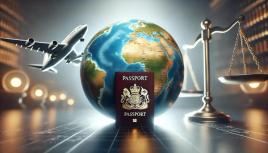Blog • Published on:September 25, 2025 | Updated on:September 25, 2025 • 7 Min
A Guide to the World's Safest Banks in 2025
In 2025, global finance feels like it’s running on two tracks at once: digital innovation on one side and rising geopolitical and economic unpredictability on the other.
While some banks are busy experimenting with AI-backed services or blockchain pilots, others are strengthening the basics, things like credit stability, capital strength, and cross-border regulatory compliance.
So, what separates a financially secure bank from the rest? Is it all about size? Location? Government backing? Not exactly.
Safety in banking comes down to very specific factors, credit ratings, capital buffers, liquidity strength, and how tightly a bank is regulated.
In this guide, we walk you through how that’s measured, who’s doing it, and which banks are coming out on top in 2025.
Understanding Global Bank Safety Rankings
When assessing the safety of banks in 2025, several key methodologies and indicators are utilized by financial institutions and regulatory bodies. Here's an overview:
Key Safety Indicators
- Capital Adequacy Ratios: Measures such as the Common Equity Tier 1 (CET1) ratio assess a bank's capital strength relative to its risk-weighted assets.
- Liquidity Coverage Ratio (LCR): Evaluates a bank's ability to withstand short-term liquidity disruptions.
- Leverage Ratio: Assesses the bank's core capital against its total assets to gauge financial stability.
- Stress Test Results: Regulatory bodies conduct stress tests to simulate adverse economic scenarios and evaluate a bank's resilience.
Current Global Banking Stability Metrics
According to S&P Global Ratings, as of 2025, approximately 80% of global banking groups maintain stable credit outlooks, indicating resilience amid economic challenges.
Moody's has also revised its global banking outlook for 2025 from negative to stable, citing stabilizing economic growth and monetary easing as key factors supporting banks' operating environments.
The International Monetary Fund (IMF) highlights that while global financial stability risks have increased due to tighter financial conditions and geopolitical uncertainties, major banks have shown resilience, supported by strong capital positions and regulatory frameworks.
These indicators and assessments provide a comprehensive view of the methodologies used to evaluate bank safety and the current stability metrics in the global banking sector for 2025.
Top 10 Safest Banks Worldwide for 2025
Based on the latest credit ratings, regulatory compliance, and financial stability metrics, here are the top 10 safest banks globally in 2025:
Top 10 Safest Banks in 2025
Note: Credit ratings are subject to change and should be verified with the respective rating agencies.
Key Factors That Make Banks Safe
Here’s what banks need to have in place to be considered safe in 2025. These are the exact things financial experts look at when deciding whether a bank can be trusted.
1. Enough Backup Money (Capital)
A safe bank keeps extra money aside in case things go south, like people defaulting on loans or a sudden market dip.
- This is what’s called “capital.”
- The more capital a bank holds, the better it can protect itself and your money.
- In 2025, many of the world’s safest banks have high capital levels, way more than what regulators ask for.
Example: Some Swiss and German banks are keeping over 20% of their assets as capital. That’s huge.
2. High Credit Ratings
- Ratings range from “AAA” (very safe) to lower scores (riskier).
- Safe banks almost always sit in the top range.
Example: RBC (Canada) and BNG (Netherlands) both hold top ratings in 2025.
3. Strong Rules to Follow
Banks that operate in countries with tight financial rules tend to be safer.
- These banks have to go through regular checks.
- They’re limited in how much risk they can take.
- They’re also required to keep enough cash on hand.
Example: Banks in Singapore and Canada have to meet strict rules, which makes them more reliable.
4. Government Support
Some banks are partly or fully owned by governments. If they ever got into serious trouble, the government would likely step in.
This doesn’t mean the bank is perfect, but it adds a layer of safety.
Example: ZKB (Switzerland) and KfW (Germany) are both backed by their local governments. That adds a lot of trust.
Investment Security in Global Banks
It’s one thing to store cash in a safe bank, it’s another to grow and protect your wealth over time.
In 2025, global banks aren’t just holding your money; they’re helping you manage, diversify, and shield it from unnecessary risk.
Here's how the safest banks are doing that today.
Asset Protection Strategies
Safe banks take steps to keep your assets legally separated from their own. That means if the bank faces trouble, your investments aren’t lumped into their liabilities. This setup (often called “custodial separation”) is especially common in private and international banks serving high-net-worth clients.
In places like Switzerland and Singapore, banks are required by law to keep client assets ring-fenced, so your holdings are shielded even in a worst-case scenario.
Wealth Management Services
Top-rated banks offer more than just financial products; they offer structured guidance. That includes:
- Long-term planning for international families
- Cross-border tax optimization
- Inheritance and estate support
In 2025, many of these services have gone hybrid, combining digital platforms with one-on-one advisors, but human oversight still plays a key role in wealth security.
Global Diversification
One of the smartest ways to reduce risk? Don’t keep everything in one currency, one country, or one market. Safe banks make it easy to spread your investments across geographies and asset types.
You’ll often see clients building portfolios with:
- Multi-currency deposits
- Global ETFs and bonds
- Real estate or private equity access in different regions
Banks like RBC (Canada), DBS (Singapore), and UBS (Switzerland) all support this kind of international positioning and provide the tools to manage it cleanly.
Risk Mitigation You Can Actually Understand
In 2025, the best banks are focused on clarity. That means no hidden fees, no vague terms, and more stress-testing of portfolios before they’re offered.
If you're working with a safe bank, they should:
- Explain how your money is invested
- Show how each investment would behave in different market conditions
- Flag risks before they become problems
Future of Safe Banking
What makes a bank “safe” isn’t standing still. In 2025, safety is being redefined, not just by stronger regulations, but by how banks adapt to new risks and technologies. The most trusted banks are thinking ahead, not just protecting money now, but building systems that stay secure tomorrow.
Emerging Technologies
Banks are leaning heavily into AI and automation, but in safety-focused ways.
Instead of replacing judgment, they’re using AI to:
- Flag suspicious activity faster (fraud, identity theft, etc.)
- Stress-test portfolios against real-world scenarios
- Improve how they monitor their own financial risk in real time
Regulatory Changes
In 2025, key changes include:
- Faster access to insured deposits during a bank failure
- Tighter liquidity rules for mid-size banks, especially in the U.S. and Europe
- Stricter oversight for non-bank financial platforms offering deposit-like services
Safe banks are staying ahead of these changes, not just complying, but adjusting early to avoid surprises.
Global Trends in Safe Banking
A few patterns are shaping what safety looks like going forward:
- Consolidation: Smaller, riskier banks are being acquired or merged into stronger groups.
- Transparency: Clients now expect clear explanations around where their money goes.
- Resilience over speed: There’s less pressure to be “fast” and more focus on long-term trust.
These shifts mean clients are more cautious and banks that can explain their stability clearly are the ones gaining ground.
FAQs About Bank Safety in 2025
1. How do I know if a bank is actually safe this year?
Check its credit rating (AAA or AA is solid), make sure it’s covered by deposit insurance, and see if it follows international banking standards. A good sign? If it's been through recent stress tests and passed.
2. What’s the biggest risk to my money in banks right now?
Cyber threats are a big one, especially for online accounts. But rising inflation and weak regulations in some countries can also put pressure on smaller or regional banks.
3. Is mobile banking safe in 2025?
Yes, as long as you're using the bank’s official app, have two-factor login, and avoid risky public Wi-Fi. Most major banks have tight cybersecurity now.
4. How does deposit insurance work in different countries?
It depends where the bank is. In the U.S., you’re insured up to $250K. In Europe, it’s usually around €100K. Singapore covers up to S$100,000. Always check the fine print before opening an account.
5. What’s the safest way to bank internationally?
Stick with well-rated banks in stable countries, diversify across a few institutions, and avoid any bank that seems too secretive or hard to research. Transparency matters more than location now.
References
S&P Global Ratings. (2025). Global Banking Outlook Midyear 2025: Stable Ratings Amid Shifting Risks. S&P Global Market Intelligence. Referred from: https://www.spglobal.com/_assets/documents/ratings/research/101608155.pdf
International Monetary Fund. (2025). Global Financial Stability Report – April 2025: Adapting to a New Normal. IMF Publications. Referred from: https://www.imf.org/en/Publications/GFSR/Issues/2025/04/22/global-financial-stability-report-april-2025
Barron’s. (2025, June 27). Big Banks Raise Dividends After Softer Fed Stress Tests. Dow Jones & Company. Referred from: https://www.barrons.com/articles/big-banks-raise-dividends-boost-buybacks-after-less-stressful-stress-test-d28dc926
Reuters. (2025, June 27). Fed Says U.S. Banks Can Withstand Recession Scenario. Reuters Finance. Referred from: https://www.reuters.com/sustainability/boards-policy-regulation/fed-says-banks-resilient-hypothetical-downturn-clearing-way-capital-plans-2025-06-27/
Written By

Andrew Wilder
Andrew Wilder is a multifaceted author on Business Migration programs all over the globe. Over the past 10 years, he has written extensively to help investors diversify their portfolios and gain citizenship or residency through innovative real estate and business investment opportunities.
Related Articles









Recently Published









Book a free consultation


